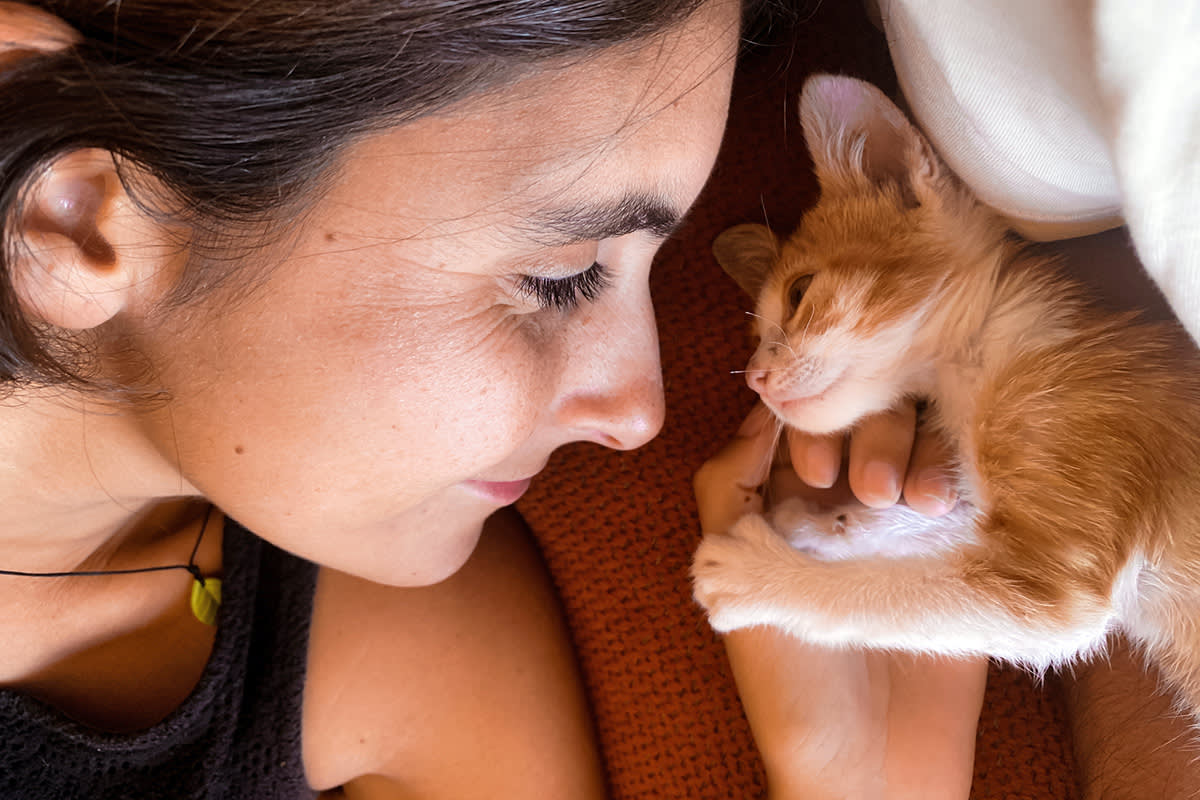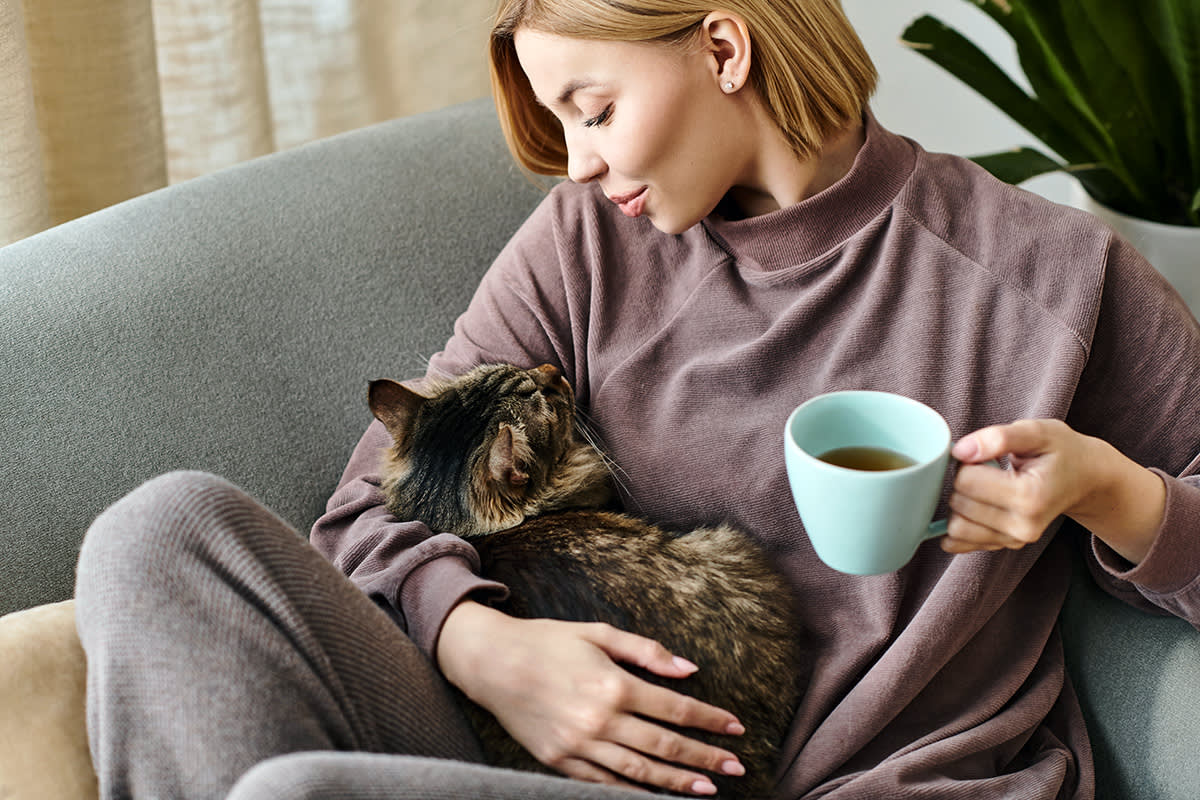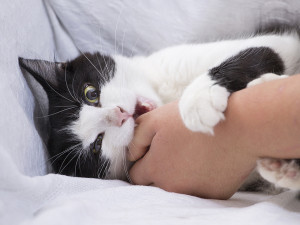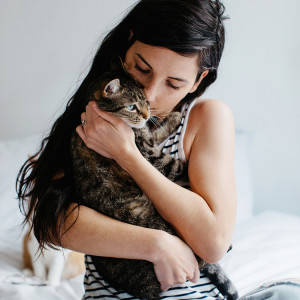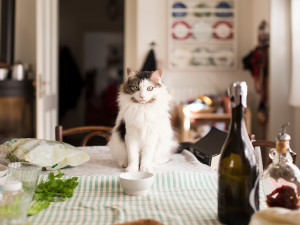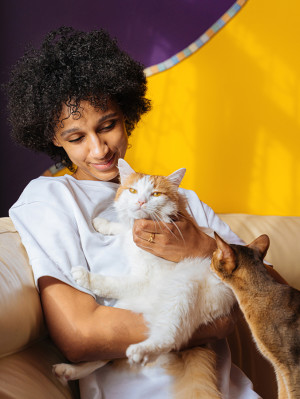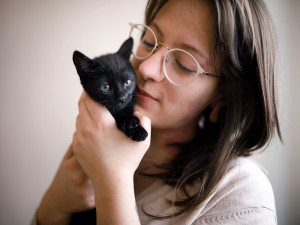Want to Say “I Love You” to Your Cat? Try Slow-Blinking
Studies show this is the best way to bond with your kitty.

Share Article
Cats often get a bad rap when it comes to showing love — and as a parent to three adorable, often inscrutable felines of my own, I get it. They seem to delight in jumping on my head when I’m trying to sleep, knocking my water glass off the edge of the table (my fault for leaving it there!), and sitting on top of my phone when I’m hunting for it. They hack up hairballs on the rug, refuse to eat their (formerly) favorite food right after I’ve bought a case of it, and look at me scornfully when I tell them how beautiful they are. Still, I know they love me, and I want them to know how much I love them, too. So, how can I tell them?
A quick Google search turns up one answer over and over again: slow-blinking. Based on a much-cited 2020 studyopens in new tab published in Scientific Reports, narrowing your eyes at your cat seems to be the best way to bond with your cat. It’s easy: All you have to do is sit face-to-face with them, settle in, relax, slowly close your eyes, keep them closed for a couple of seconds, and then open them again. When you do this slow-blink routine with your cat, researchers say they’re likely to do it back to you (swoon), and they’re also more likely to approach you for pets and cuddles afterward.
Does it really work? I asked cat behaviorist Stephen Quandt, who has worked with thousands of cats over the past 20 years, if he’s tried it. He told me that not only has he slow-blinked at cats, they do it back to him all the time. “Just the other day, I was at the shelter, and a cat engaged in a textbook slow-blink sequence that appeared clearly directed at me after I engaged in some gentle sweet talk with the cat,” he says. “I repeated it to him, and then he repeated it back again to me. And I have seen cats who are not actively engaging in slow-blinks begin to slow-blink after I slow-blink to them.”
The real question, Quandt says, is whether slow-blinking truly enhances the human-cat relationship. “Speaking anecdotally, I believe that it does, but I rely on studies [like the one in Scientific Reports] to provide more systematic evidence.” He also notes that cats who engage in slow-blinking are usually calm. “I have rarely seen a cat slow-blink who was obviously stressed out,” he says.

Sometimes, though, he suspects that an anxious cat may use slow-blinking to tug on our heartstrings. “I feel that some cats in the shelter are trying to offer an olive branch of sorts by doing a little slow-blinking while obviously stressed.” (If that isn’t enough to melt your heart, I don’t know what is.)
If you want to try doing this with your cat, veterinarian Dr. Liza Cahnopens in new tab, a consultant for Embrace Pet Insuranceopens in new tab, has a few pointers to help get across your message that says, I love you enough to overlook your obnoxious and sometimes disgusting behavior. “Keep your face relaxed and smile with your eyes or slowly blink them, crouch on the ground to the side of your cat with your hand extended, use a calm voice, and let them approach you on their own terms. To help your cat feel more at ease, avoid towering over them, approaching from the front, sudden movements, loud noises, and direct stares,” she says.
A slow-blink in return is one sign that your cat understands and reciprocates your silent signal of love and affection, but Dr. Cahn says there are other ways cats show that they’re feeling relaxed and happy in your presence. “They may be sprawled out with their tail loosely hanging or curled around their body, ears and whiskers relaxed and forward facing, and eyes that are relaxed or slowly blinking.”
Is slow-blinking the best way to tell your cat you love them? Maybe, maybe not. Veterinarian Dr. Preston Turano says that in general, cats rely more on their senses of smell and hearing to navigate the world, rather than vision. “There will always be discussion around what exactly a cat may see, and how well,” he says. “Since they can’t tell us, we will never truly know.”
However, Dr. Turano says that’s no reason not to try slow-blinking, or even other facial expressions, such as smiling (apparently, cats hate it when you frown). “There is no reason not to try different expressions and see if they incite a positive response from your cat. Every cat is unique and has their own personality, so a facial expression that works for your cat might differ from another. As long as it’s done in a positive manner to help strengthen the human animal bond, then go ahead and try,“ he says.
I’m not sure if my cats fully appreciate my slow-blinking; it’s hard to tell if they’re doing it back, or if they’re just glaring at me. I’ll keep doing it, though — and maybe I’ll throw in some kissy-faces and see how that goes over.
References
Humphrey, Tasmin, et al. “The Role of Cat Eye Narrowing Movements in Cat–Human Communication.” Scientific Reports, vol. 10, no. 1, 5 Oct. 2020, p. 16503, www.nature.com/articles/s41598-020-73426-0, https://doi.org/10.1038/s41598-020-73426-0opens in new tab.
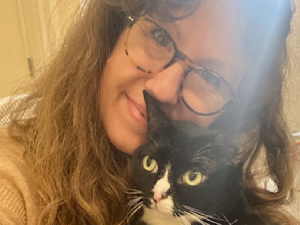
Elizabeth Laura Nelson
Elizabeth Laura Nelson is a writer and editor based in Brooklyn, New York, whose work has appeared in The New York Times, Jenny, Best Life, YourTango, Elite Daily, and more. She focuses her work on relationships, health and wellness, midlife, and lifestyle. As a child, Elizabeth was scared of cats (claws and teeth, yikes) but she has since gotten over her fear and now shares her home with three sweet and gentle feline companions who make life better (and cuddlier) every day.
Related articles
![]()
How to Read Your Cat’s Poker Face
A guide to their not-so-secret tells.
![cat biting person's hand]()
Why Does My Cat Bite Me?
Don’t live in fear of your feline overlord.
![dark-haired woman hugging cat that has imprinted on her]()
10 Signs Your Cat Has Imprinted on You
Feeling like you have a little shadow these days? Here’s why that’s happening.
![cat staring at person on table]()
Why Does My Cat Stare at Me?
...Is it something you said?
![A woman with curly black hair sitting in front of a dark purple and yellow backdrop while looking down affectionately at her two cats sitting on her lap]()
How to Build Your New Cat’s Trust in You
If your cat still approaches you with a figurative arched eyebrow of skepticism, try these tricks to put them at ease.
![Relaxed girl holding a black kitten near her face.]()
What to Expect When Fostering a Kitten
Besides plenty of cuteness, of course.
